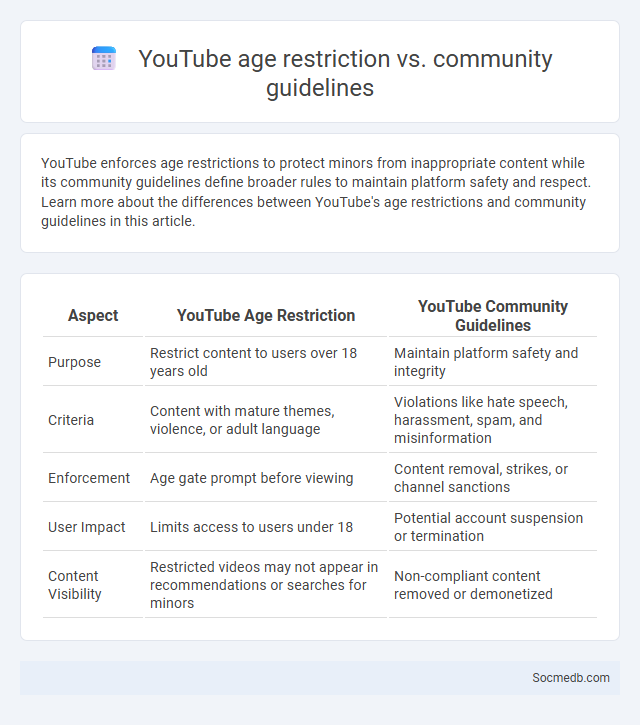
Photo illustration: YouTube age restriction vs community guidelines
YouTube enforces age restrictions to protect minors from inappropriate content while its community guidelines define broader rules to maintain platform safety and respect. Learn more about the differences between YouTube's age restrictions and community guidelines in this article.
Table of Comparison
| Aspect | YouTube Age Restriction | YouTube Community Guidelines |
|---|---|---|
| Purpose | Restrict content to users over 18 years old | Maintain platform safety and integrity |
| Criteria | Content with mature themes, violence, or adult language | Violations like hate speech, harassment, spam, and misinformation |
| Enforcement | Age gate prompt before viewing | Content removal, strikes, or channel sanctions |
| User Impact | Limits access to users under 18 | Potential account suspension or termination |
| Content Visibility | Restricted videos may not appear in recommendations or searches for minors | Non-compliant content removed or demonetized |
Understanding YouTube’s Age Restriction Policy
YouTube's age restriction policy limits access to videos containing mature content, requiring users to be at least 18 years old or the legal age in their country to view them. This policy helps protect younger audiences from exposure to explicit material, violent content, and other sensitive subjects. Content creators must comply with YouTube's guidelines to avoid automatic restrictions or demonetization of their videos.
What Are YouTube Community Guidelines?
YouTube Community Guidelines are a set of rules designed to maintain a safe, respectful, and enjoyable environment for all users on the platform. These guidelines cover content restrictions such as hate speech, violent or graphic material, harassment, and misinformation to protect creators and viewers alike. Understanding and following YouTube's Community Guidelines helps you avoid content removal or account suspension while promoting positive engagement within the community.
Key Differences: Age Restriction vs. Community Guidelines
Age restrictions on social media platforms set a minimum age, typically 13, to protect younger users from inappropriate content and comply with legal requirements like COPPA. Community guidelines outline acceptable behavior and content standards, aiming to foster a safe and respectful environment for all users. Understanding these differences helps you navigate platform rules effectively while ensuring compliance and online safety.
Reasons YouTube Applies Age Restrictions
YouTube applies age restrictions primarily to comply with legal regulations such as the Children's Online Privacy Protection Act (COPPA) and to protect minors from inappropriate content including violence, explicit language, and adult themes. Age restrictions also help advertisers target suitable audiences and maintain platform safety by limiting exposure to potentially harmful videos. These measures ensure a safer viewing environment tailored to the maturity level of users.
How Community Guidelines Enforce Platform Safety
Community guidelines play a crucial role in maintaining platform safety by establishing clear rules that prohibit harmful content such as hate speech, harassment, and misinformation. These guidelines enable social media platforms to implement automated monitoring tools and human moderation to swiftly detect and remove violations, ensuring a secure and respectful user environment. Enforcing these standards helps protect users' mental health, fosters positive online interactions, and upholds legal and ethical responsibilities.
Impact of Age Restriction on Video Reach and Monetization
Age restriction on social media platforms significantly limits video reach by reducing visibility in search results and algorithmic recommendations, directly affecting audience growth. Monetization potential is also impacted as advertisers often avoid age-restricted content to comply with brand safety guidelines, resulting in decreased ad revenue. Consequently, creators targeting younger demographics face challenges in both engagement and earnings when age restrictions are imposed.
Common Violations of Community Guidelines
Common violations of social media community guidelines include hate speech, harassment, and the spread of misinformation. Content promoting violence, nudity, or illegal activities often results in account suspension or removal. Protecting Your online presence requires understanding and adhering to these platform-specific rules to avoid penalties.
How Creators Can Appeal Age Restrictions
Creators can appeal age restrictions on social media by submitting a formal request to the platform's support team, providing valid identification to verify their age and proof of content compliance with community guidelines. Ensuring your account details, such as date of birth, are accurate and up to date is essential for a successful appeal process. Platforms like Instagram, TikTok, and YouTube have specific forms and procedures tailored for age verification and appeals to help restore access promptly.
Protecting Young Audiences: Age Gates and Parental Controls
Protecting young audiences on social media requires robust age gates designed to verify users' ages accurately, preventing underage access to inappropriate content. Parental controls offer essential tools for You to monitor and restrict your child's online interactions, ensuring a safer digital experience. Implementing these measures helps mitigate risks like cyberbullying, exposure to harmful content, and privacy breaches among minors.
Navigating YouTube Compliance as a Content Creator
Navigating YouTube compliance requires content creators to understand and adhere to platform policies including copyright rules, community guidelines, and advertising standards. You must regularly review YouTube's policies on monetization, content strikes, and age-restricted content to avoid penalties or demonetization. Staying informed about algorithm updates and using tools like YouTube Studio helps protect your channel's integrity and maintain audience engagement.
 socmedb.com
socmedb.com